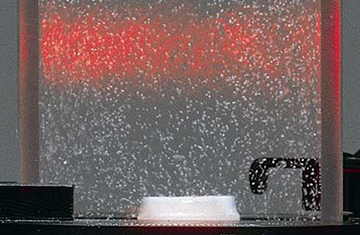Adhesive forces between particles
The attraction forces observed most frequently are Van der Waals forces (dipole interactions between atoms and molecules), which are effective on adjacent surfaces. These have a small range but, in the event of close contact between very small solid particles that are under 10 µm, they are hugely important and play a role in both gaseous and liquid media. In addition, binding forces resulting from liquid bridges are formed if coarser particles are exposed to liquid (residual damp) in otherwise dry, gaseous environments. The surface tension of the liquid creates a capillary vacuum, which pulls the particles towards one another. Electrostatic attraction also takes place between particles with oppositely charged surfaces; this can play a significant role in particular in the event of micro grains below 50 µm. In addition, some materials themselves have magnetic properties, which further increase the attraction forces and tendency to bind.
However, with particle sizes above 50 µm, it is mostly mass forces (gravity, centrifugal force and inertia) or surface forces (incident flow and buoyancy) that dominate, and work against binding forces and the formation of agglomerates – particularly if the dispersed systems are in motion. Here, moderate acceleration of the particles (in the injector or freefall shaft) or circulation and upstream flow in a measurement circuit, are sufficient in most cases. For particle sizes under 50 µm, the targeted and product-appropriate introduction of effective dispersion forces is of increasing importance in separating particles with a decreasing particle size.
The stated particle sizes are used only for general orientation and to illustrate the importance of overlapping or opposing forces. The actual binding forces must always be assessed based upon the specific product.
Types of Dispersion
Solid particles are subject to various binding mechanisms, which – depending on particle size, the properties of the substance, particle concentration, and dispersion medium – result in the agglomeration of the individual particles. The purpose of dispersion is to overcome the binding forces between the agglomerated particles, in order to make them measurable by the sensor as individual particles.













